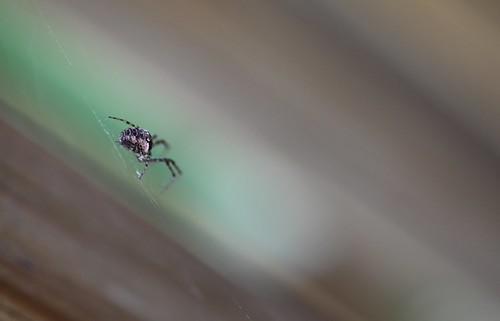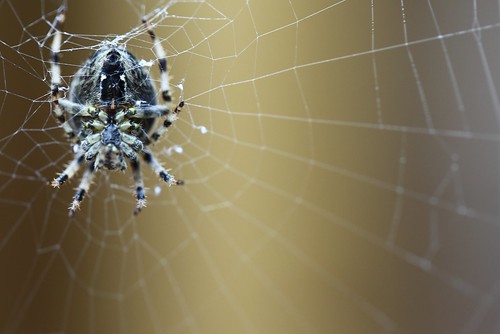For my current assignment I need to produce three photographs that make deliberate use of gestalt principles.
Usually when taking shots I would concentrate on things like leading lines, simplifying and the rule of thirds. Whilst elements of these techniques do cross over with the gestalt principles, it will be a new way of building images for me and is something that I'm looking forward to giving a go.
The one that I'm mostly interested in using is the law of closure and in particular the formation of triangles in the composition.
As for subject matter for the shoot, I'm still a bit unsure as too what it will be. I haven't done much in the way of street photography previously so I may try some for this assignment. Alternatively their are a few new buildings in Belfast that I'd like to get some shots of so this may be a good opportunity to do so.
Thursday 18 November 2010
Monday 18 October 2010
Gestalt
For the next project I have to look at Gestalt psychology and then produce three images which use it's principles within their composition.
Gestalt is the name given to a series theories that where devised by a group of German and Austrian psychologists in the early 20th Century. From these theories a number of laws and principles were created that can be used in artistic composition in order to have an effect on how the viewer perceives an image.
Some of these Gestalt principles have been used to great effect by artists such as M. C. Escher and Salvador Dali.
Whilst the theories laid out by Gestalt are not perfect they can be used by photographers in order to make more interesting shots. The main interest for photographers lies within the Gestalt laws of perceptual organisation which are as follows.
1. Law of Proximity.
The mind organises elements within a photograph according to how close they are to each other.
2. Law of Similarity.
The mind tends to group together objects or elements that are similar either by shape or content.
3. Law of Closure.
The mind seeks to create recognisable shapes from groups of elements in order to create completeness.
4. Law of Simplicity.
The mind seems to prefer simple shapes and lines as well as balance and symmetry.
5. Law of Common Fate.
Elements that are grouped together in an image are perceived by the mind to move together as one.
6. Law of Good Continuation.
The mind tends to attempt to continue shapes and lines beyond the limits of the image.
7 Law of Segregation.
to allow the mind to perceive an element within an image it must stand out from the background.
Gestalt is the name given to a series theories that where devised by a group of German and Austrian psychologists in the early 20th Century. From these theories a number of laws and principles were created that can be used in artistic composition in order to have an effect on how the viewer perceives an image.
Some of these Gestalt principles have been used to great effect by artists such as M. C. Escher and Salvador Dali.
Whilst the theories laid out by Gestalt are not perfect they can be used by photographers in order to make more interesting shots. The main interest for photographers lies within the Gestalt laws of perceptual organisation which are as follows.
1. Law of Proximity.
The mind organises elements within a photograph according to how close they are to each other.
2. Law of Similarity.
The mind tends to group together objects or elements that are similar either by shape or content.
3. Law of Closure.
The mind seeks to create recognisable shapes from groups of elements in order to create completeness.
4. Law of Simplicity.
The mind seems to prefer simple shapes and lines as well as balance and symmetry.
5. Law of Common Fate.
Elements that are grouped together in an image are perceived by the mind to move together as one.
6. Law of Good Continuation.
The mind tends to attempt to continue shapes and lines beyond the limits of the image.
7 Law of Segregation.
to allow the mind to perceive an element within an image it must stand out from the background.
Thursday 23 September 2010
Imbalance (Balance task)
I found that showing imbalance in photographic composition is a bit more tricky than getting a balanced shot.
Choosing a composition that is not balanced can often result in a photograph that is full of tension and has an uncomfortable feel about it. For this reason I wanted to pick the subject matter quite carefully.
Recently I have noticed that the spider population in my back garden seems to be growing at a fast rate and although I don't have a problem with them I am aware that people can often have a very real fear off them.
I though that I could play on this and attempt to portray them in a way that would give the very an uneasy feeling due to the shots being imbalanced.
Choosing a composition that is not balanced can often result in a photograph that is full of tension and has an uncomfortable feel about it. For this reason I wanted to pick the subject matter quite carefully.
Recently I have noticed that the spider population in my back garden seems to be growing at a fast rate and although I don't have a problem with them I am aware that people can often have a very real fear off them.
I though that I could play on this and attempt to portray them in a way that would give the very an uneasy feeling due to the shots being imbalanced.
With all of these shots I have used isolation to create imbalance within the composition. This has been done by getting in close to the spiders, using a 100mm macro lens, so as there are no distracting elements within the frame.
Also by using a wide aperture I was able to create a very shallow depth of field so as the background is completely blurred without any detail in it at all.
With these shots the viewers eye tends to try and move from the spider in order to focus on something else but finds nothing so has to immediately return to the subject matter and it is this that creates tension in the images.
Balance
To get some shots using balance I headed of to Belfast docks, which now seems to called the Titanic Quarter, to photograph the Harland and Wolfe cranes which dominate the skyline of East Belfast.
This was also the first outing for my new Cannon 5d and 100mm lens so I was looking forward to seeing how it performed and also learning how to use it.

With this shot of one of the smaller cranes at the docks I have tried to used the shape of the clouds to add balance to the composition.
In this case the area of blue sky at top right of the photograph balances with the main subject matter as it is of similar size and shape.
To get this shot it was necessary to wait until the clouds moved into a position that made this composition possible.

With this shot I have tried to use a similar technique as with the shot above. Again the contrasting blue sky has been used to balance against the colour and shape of they yellow crane.
The shot has been composed in such a way that the the shape of the blue sky area creates an almost mirror image to the main subject matter.

This shot shows part of the newish Victoria Square complex in Belfast.
With this shot I wanted to balance the tower which is quite a weighty architectural feature with the sail like sun shade.
I think that this shot demonstrates how an object that can be perceived as heavy can be balanced with a lighter object that is closer to or in this case extends beyond the edge of the frame.
This was also the first outing for my new Cannon 5d and 100mm lens so I was looking forward to seeing how it performed and also learning how to use it.

With this shot of one of the smaller cranes at the docks I have tried to used the shape of the clouds to add balance to the composition.
In this case the area of blue sky at top right of the photograph balances with the main subject matter as it is of similar size and shape.
To get this shot it was necessary to wait until the clouds moved into a position that made this composition possible.

With this shot I have tried to use a similar technique as with the shot above. Again the contrasting blue sky has been used to balance against the colour and shape of they yellow crane.
The shot has been composed in such a way that the the shape of the blue sky area creates an almost mirror image to the main subject matter.

This shot shows part of the newish Victoria Square complex in Belfast.
With this shot I wanted to balance the tower which is quite a weighty architectural feature with the sail like sun shade.
I think that this shot demonstrates how an object that can be perceived as heavy can be balanced with a lighter object that is closer to or in this case extends beyond the edge of the frame.
Sunday 5 September 2010
First task - Balance
The first task that I have been given in this course is to produce 6 images that explore that theme of balance within composition. 3 shots will be balanced and 3 are to show imbalance.
The use of balance in photography is a compositional tool which can be used to give a certain feeling within the image. For example if the photographer wishes to portrait a scene as being harmonious or calm then the composition should show some balance, conversely, if the intention is to show an image containing some tension then the composition should be imbalanced.
Balance can be obtained using various techniques such as using symmetry, used of colour and by placing similar elements next to each other in images.
To create imbalance we can shift the view to isolate the subject matter and give the viewer nowhere else for their eye to travel to.
The use of balance in photography is a compositional tool which can be used to give a certain feeling within the image. For example if the photographer wishes to portrait a scene as being harmonious or calm then the composition should show some balance, conversely, if the intention is to show an image containing some tension then the composition should be imbalanced.
Balance can be obtained using various techniques such as using symmetry, used of colour and by placing similar elements next to each other in images.
To create imbalance we can shift the view to isolate the subject matter and give the viewer nowhere else for their eye to travel to.
Thursday 26 August 2010
Tutor picked
One of the features of the Open College of the Arts (OCA) courses is that you a required to choose your own tutor. A list of tutors that are available now has been emailed to me.
After a quick bit of research on the five available tutors I have picked Clive White. I wanted to get a tutor with plenty of experience in different aspects of photography, and looking at Clive's website and his biography page on the OCA website, he certainly seems to have plenty.
Most of all I, really like the shots on his website and it's definitely the sort of photography that I aspire to.
I have also now received all of the course materials which is quiet exiting as it means I can now start the course properly. It also included a student card so I'm now looking forward to cheap cinema tickets and student discos.
I now am required to make contact with Clive by sending him a "Student Profile" containing some particular information as defined by the OCA.
So here goes...
Course title: Level 3 Photography. Your own portfolio
URLs: www.CraigButlerPhotography.com
email: belfast_craig@hotmail.com
Previous experience: I've been studying photography for a few years now starting with a GCSE and then an A Level which I was awarded a grade B for both. For the last 3 years I have been doing and HND in photography which is now complete.
Expectations: Through this course I would like to continue developing my photography and eventually earn a BA (hons). I am also keen to develop my own style of photography and hopefully sell some work in order that I can begin to create an income from it although I don't want to go full time just yet. I am especially interested in fine art prints and stock libraries.
After a quick bit of research on the five available tutors I have picked Clive White. I wanted to get a tutor with plenty of experience in different aspects of photography, and looking at Clive's website and his biography page on the OCA website, he certainly seems to have plenty.
Most of all I, really like the shots on his website and it's definitely the sort of photography that I aspire to.
I have also now received all of the course materials which is quiet exiting as it means I can now start the course properly. It also included a student card so I'm now looking forward to cheap cinema tickets and student discos.
I now am required to make contact with Clive by sending him a "Student Profile" containing some particular information as defined by the OCA.
So here goes...
Course title: Level 3 Photography. Your own portfolio
URLs: www.CraigButlerPhotography.com
email: belfast_craig@hotmail.com
Previous experience: I've been studying photography for a few years now starting with a GCSE and then an A Level which I was awarded a grade B for both. For the last 3 years I have been doing and HND in photography which is now complete.
Expectations: Through this course I would like to continue developing my photography and eventually earn a BA (hons). I am also keen to develop my own style of photography and hopefully sell some work in order that I can begin to create an income from it although I don't want to go full time just yet. I am especially interested in fine art prints and stock libraries.
Monday 23 August 2010
So I finally finished the HND in Photography at Lurgan and have now decided to do a BA Hons in Photography with the Open College of the Arts (OCA).
I first had to apply for credits for the HND which was a pretty straightforward process. It was just a matter of sending of a form to OCA along with some evidence of my previous studies. That was accepted without any issues, so I then had to register with New Bucks University before finally paying for the actual courses via the OCA website.
The courses that I have subscribed to are "Level 3: Your own Portfolio" and "Advanced"
Now I just have to choose a tutor, that will lead my through the courses, and then I will receive the course materials and be ready to go.
I first had to apply for credits for the HND which was a pretty straightforward process. It was just a matter of sending of a form to OCA along with some evidence of my previous studies. That was accepted without any issues, so I then had to register with New Bucks University before finally paying for the actual courses via the OCA website.
The courses that I have subscribed to are "Level 3: Your own Portfolio" and "Advanced"
Now I just have to choose a tutor, that will lead my through the courses, and then I will receive the course materials and be ready to go.
Subscribe to:
Posts (Atom)


